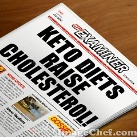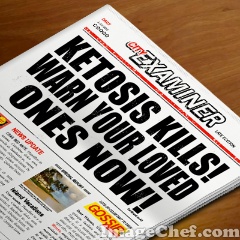My ketogenic diet plan results really shocked me, after all it was so different to anything I’d tried before and went completely against everything I thought I knew about nutrition.
How could eating fatty cuts of meat, burgers, cheese and cooking everything in butter possibly be healthy, let alone able to help me lose fat without ever feeling hungry?!

At the time those thoughts were running through my mind I’d just started following a keto diet and I wasn’t sure it was going to work.
I was wrong! I lost 28 pounds in 16 weeks in what was my first ever successful fat loss diet. Every other attempt to get lean ended in a binge as I was constantly hungry and irritable.
Not keto, I was happy and full up eating rich tasty food and the results were far better than I expected.
Also, my research into the health implications of a high fat diet were enlightening and I discovered that you health can actually improve by reducing carb intake in favour of fat.
I found the ketogenic diet to tick all of the boxes for me:
- Healthy
- Fulfilling
- Tasty
- Easy to stick to
- Flexible on weekends
- Easy to find keto food on-the-go
- Good lifestyle choice
Despite the warnings from everyone who knew I was going keto I didn’t die of heart disease or clogged arteries or get fat despite everyone telling me I was destined for health problems.
In fact, I got leaner than I ever have before; I felt healthier, had more energy and experienced very little hunger during the diet.
Ketogenic dieting could be a great option for you too especially if you don’t want to count calories or struggle with hunger and sugar cravings during dieting.
Isn’t A Ketogenic Diet Plan Dangerous?
There’s a lot of misinformation spread about the risks of a high fat diet when in reality sugar is much more of a menace to our health.
In this series of articles I dispel some of the most common myths attributed to the ketogenic diet plan and explains why they’re simply not true and show that science backs this up.
Keto Myth #1: High Fat Diets Cause High Cholesterol
Some of the common accusations slung at the ketogenic diet plan is that it causes high cholesterol, I examined this in detail by looking at scientific studies in this article:

Dangers of Low Carb Diets: Keto and Cholesterol Under The Spotlight!
Are the dangers of low carb diets unfounded propaganda or genuine health risks?
In this article we examine ketogenic diets and their impact on cholesterol levels.
Keto Myth #2: Ketosis is Potentially Fatal
Another common misconception is that ketosis is a toxic state to be in and that the body needs carbs to survive.
This myth is perpetuated by people not understanding the difference between ketosis and ketoacidosis (the toxic state)
In this article I explain the difference and show you how ketosis can only ever be dangerous if you are diabetic or an alcoholic. Diabetics can still follow a ketogenic diet plan and everyone else has nothing to worry about!

Is Ketosis Dangerous? The Facts About Ketosis vs. Ketoacidosis
Is ketosis dangerous?
The answer is no, this is the most common misconception about ketogenic dieting. In this article I explain the difference between ketosis and ketoacidosis.
Keto Myth #3: The Body Needs Carbs To Function
Whilst carbohydrates are the preferred fuel source for the body, it can infact run on 4 different fuel sources.
This article explains how the body is fuelled and what you need to do to get it burning fat for fuel:

Ketogenic Dieting Explained: A Plain English Guide For Beginners
Can the body use fat for fuel? What is ketosis?
This guide answers these questions and gives you the facts about the Ketogenic diet plan and how the body is fuelled.
How Do You Know You’re In Ketosis?
People use a range of ways to know whether or not they’re in ketosis, some of these include Keto sticks which you urinate on and watching for a metallic or fruit breath amongst others.
Method 1: Use Keto Sticks
Keto sticks are cheap to buy and are usually used by diabetics only, however, people following the Ketogenic diet plan also use these to assess if they’re in ketosis or not.
In this article we take a look at Keto sticks and determine how useful they really are:

Keto Sticks: Fat Burning Indicators or a Fat Waste of Money?
Keto sticks tell you if you are in ketosis and many Ketogenic dieters use them to tell if they are burning fat, but do they really do what they claim?
Method 2: Ketone Breath
When the body burns fat for fuel ketones are excreted through your breath, this is why some dieters notice a metallic or fruity taste when they’re in ketosis.
In this article I explain what ketone breath is and show you how to combat it so you can enjoy fat loss without smelly breath:

Ketone Breath Can Drive Your Friends and Family Away!
Ketone breath has been known to end relationships and even test family ties!
Read this guide and do something about it today! Your future depends on it!
What To Eat on Keto?
Keto food is tasty as hell and you’ll never be hungry even when dieting, but still people get stuck in the habit of eating the same foods every day.
This database of keto food will give you a handy list of keto safe food you can refer to whenever you need it:

Keto Food Database: A Complete Guide to Keto Friendly Foods
This Keto food database is your handy companion that you can print off and take anywhere with you.
You’ll then always have a pocket full of options even when you’re on the go and need to grab something quickly!
Which Ketogenic Diet Plan is Right For YOU?
There are 3 ketogenic diet types all of them with unique pro’s and cons. To help you decide which is right for you read this guide and then delve deeper into the 3 keto diets:
Take the time to get this right and determine which style of keto dieting fits your lifestyle.
Are You Ready To Start Your Ketogenic Diet Plan?
The Ketogenic Diet is the most comprehensive ketogenic diet book in existence.
Written by the highly respected Lyle McDonald it really is the essential guide to the ketogenic diet plan which answers every question you could have in detail.
The table of contents gives you an idea of the depth of information in this book:
Table of contents
Section I: Introduction
- 1. Introduction to the ketogenic diet
- 2. History of the ketogenic diet
Section II: The physiology of ketosis
- 3. Fuel utilization
- 4. Basic ketone body physiology
- 5. Adaptations to ketosis
- 6. Changes in body composition
- 7. Other effects of the ketogenic diet
Section III: The diets
- 8. Setting calorie levels
- 9. The standard ketogenic diet (SKD)
- 10. Carbs and the ketogenic diet
- 11. The targeted ketogenic diet (TKD)
- 12. The cyclical ketogenic diet (CKD)
Section IV: Other topics for the ketogenic diet
- 13. Breaking fat loss plateaus
- 14. Ending a ketogenic diet
- 15. Tools for the ketogenic diet
- 16. Final considerations
Section V: Exercise physiology
- 17. Muscular physiology and energy production
- 18. Aerobic exercise
- 19. Interval training
- 20. Weight training
- 21. The effect of exercise on ketosis
- 22. Exercise and fat loss
Section VI: Exercise guidelines
- 23. General exercise guidelines
- 24. Aerobic exercise
- 25. Interval training
- 26. Weight training
Section VII: Exercise programs
- 27. Beginner programs
- 28. Intermediate programs
- 29. The advanced CKD workout
- 30. Fat loss for pre-competition bodybuilders
Section VIII: Supplements
- 31. Supplements
Index
This complete guide shows you how to set up all 3 ketogenic diet types and covers, food, workouts and everything you need to know.
You can find out more and read a sample chapter for free by clicking the image below:

